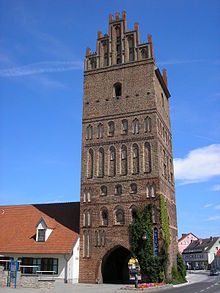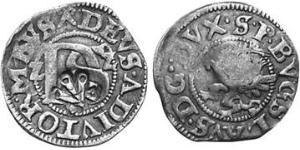| Anklamfrom the Wikipedia | Read original article |
| Anklam | ||
|---|---|---|

Market square
|
||
|
||
| Coordinates: 53°51′N 13°41′E / 53.850°N 13.683°ECoordinates: 53°51′N 13°41′E / 53.850°N 13.683°E | ||
| Country | Germany | |
| State | Mecklenburg-Vorpommern | |
| District | Vorpommern-Greifswald | |
| Government | ||
| • Mayor | Michael Galander (Ind.) | |
| Area | ||
| • Total | 56.57 km2 (21.84 sq mi) | |
| Elevation | 5 m (16 ft) | |
| Population (2013-12-31)[1] | ||
| • Total | 12,797 | |
| • Density | 230/km2 (590/sq mi) | |
| Time zone | CET/CEST (UTC+1/+2) | |
| Postal codes | 17389 | |
| Dialling codes | 03971 | |
| Vehicle registration | OVP | |
| Website | www.anklam.de | |
Anklam (German pronunciation: [ˈaŋklam] (![]() listen)) is a town in the Western Pomerania region of Mecklenburg-Vorpommern, Germany. It is situated on the banks of the Peene river, just 8 km from its mouth in the Kleines Haff, the western part of the Stettin Lagoon. Anklam has a population of 14,603 (2005) and was the capital of the former Ostvorpommern district. Since September 2011, it is part of the district Vorpommern-Greifswald.
listen)) is a town in the Western Pomerania region of Mecklenburg-Vorpommern, Germany. It is situated on the banks of the Peene river, just 8 km from its mouth in the Kleines Haff, the western part of the Stettin Lagoon. Anklam has a population of 14,603 (2005) and was the capital of the former Ostvorpommern district. Since September 2011, it is part of the district Vorpommern-Greifswald.
Contents
History[edit]

In the Early Middle Ages, there was an important Scandinavian and Wendish settlement near the present town, now known as Altes Lager Menzlin.
Anklam was founded on the site of an abandoned Wendish fortress during the medieval German Ostsiedlung. First named after the founder Tanglim, it obtained German town law in 1244. In 1283, it became a member of the Hanseatic League. [2] Though the town was small and non-influential compared to other Hanseatic cities, membership brought wealth and prosperity to Anklam.
The decline of Anklam began with the Thirty Years' War, when Swedish and Imperial troops battled almost twenty years for Anklam. Anklam was occupied by imperial forces from 1627 to 1630,[3] and thereafter by Swedish forces.[4] After the war, Anklam became part of Swedish Pomerania in 1648. In 1676 was captured by Frederick William, Elector of Brandenburg.[2]
In 1713, Anklam was looted by soldiers of the Russian Empire. That it was not burned to the ground, as ordered by Peter the Great, was in large part due to the resistance of Christian Thomesen Carl ("Carlson"), after whom a street is named in remembrance.
The southern parts of the town were ceded to the Kingdom of Prussia by the peace of Stockholm in 1720, while the smaller section north of the Peene River remained Swedish. Anklam was thus a divided town until 1815, when all of Western Pomerania became Prussian in the Province of Pomerania.
Anklam was nearly completely destroyed by several bombing raids of the U.S. Airforce in 1943 and 1944 and in the last days of World War II, when the advancing Soviets burned and leveled most of the town. After Prussia and its Pomeranian province were dissolved and most of Pomerania was allocated to Poland under the terms of the Potsdam Conference, Anklam became part of the East German state of Mecklenburg-Vorpommern. That was soon to be dissolved, too, and Anklam was within the district of Neubrandenburg. The town was rebuilt in the rather uniform socialist style.
After the 1990 reunification of Germany, Anklam became part of the state of Mecklenburg-Vorpommern, re-created at that time.
Sights[edit]
Formerly, Anklam was a town of considerable military importance and suffered severely during the Thirty Years' War, Seven Years' War and the Second World War. This, together with the repeated incidents of fire and the plague, has made its history often tragic. The fortifications of Anklam were dismantled in 1762, although the old walls are still standing. [2] Anklam has some significant buildings remaining. The church of St Mary, founded in the 13th century and with its present form by the 15th century, was damaged but not destroyed in the war and repaired by 1947.[5]

Museums[edit]
- Museum im Steintor (local history)
- Otto-Lilienthal-Museum
Economy and infrastructure[edit]
Anklam's industries consists of iron foundries and factories for sugar and soap. There is also a military school. The Peene is navigable up to the town, and some shipbuilding is carried on at wharves on the river. Anklam has a station on the Berlin-Stralsund railway line, and is connected with the Autobahn 20 coastal highway.
Transport[edit]
Anklam is connected with the Autobahn 20 coastal highway.
- Anklam railway station is served by national and local services to Angermünde, Berlin, Dresden, Eberswalde, Frankfurt, Münich, Prague and Stralsund.
People of Anklam[edit]
- Christian Andreas Cothenius, prominent physician
- Heinrich Hannover, German jurist and author
- Ulrich von Hassell, German diplomat and anti-Nazi resistance fighter
- Ludwig von Henk, German vice-admiral
- Gustav Lilienthal, German master builder and social reformer
- Otto Lilienthal, German aviation pioneer
- Günter Schabowski, German politician
- Matthias Schweighöfer, German actor
- Julius Urgiss, German-Jewish screenwriter and critic for Kinematograph
- Max Wagenknecht, German composer
International relations[edit]
Anklam is twinned with:
See also[edit]
References[edit]
- ^ "Bevölkerungsstand der Kreise, Ämter und Gemeinden in Mecklenburg-Vorpommern 31.12.2013". Statistisches Amt Mecklenburg-Vorpommern (in German). 23 September 2014.
- ^ a b c Chisholm 1911.
- ^ Langer, Herbert (2003). "Die Anfänge des Garnisionswesens in Pommern". In Asmus, Ivo; Droste, Heiko; Olesen, Jens E. Gemeinsame Bekannte: Schweden und Deutschland in der Frühen Neuzeit (in German). Berlin-Hamburg-Münster: LIT Verlag. p. 403. ISBN 3-8258-7150-9.
- ^ Langer, Herbert (2003). "Die Anfänge des Garnisionswesens in Pommern". In Asmus, Ivo; Droste, Heiko; Olesen, Jens E. Gemeinsame Bekannte: Schweden und Deutschland in der Frühen Neuzeit (in German). Berlin-Hamburg-Münster: LIT Verlag. p. 397. ISBN 3-8258-7150-9.
- ^ Brick Gothic Heritage
- Attribution
 This article incorporates text from a publication now in the public domain: Chisholm, Hugh, ed. (1911). "Anklam". Encyclopædia Britannica 2 (11th ed.). Cambridge University Press.
This article incorporates text from a publication now in the public domain: Chisholm, Hugh, ed. (1911). "Anklam". Encyclopædia Britannica 2 (11th ed.). Cambridge University Press. "Anklam". The American Cyclopædia. 1879.
"Anklam". The American Cyclopædia. 1879.
Sources[edit]
- Gottfried Heinrich Gengler: Regesten und Urkunden zur Verfassungs- und Rechtsgeschichte der deutschen Städte im Mittelalter, Erlangen 1863, p. 47, see also pp. 962-966.
- Gustav Kratz: Die Städte der Provinz Pommern: Abriß ihrer Geschichte, zumeist nach Urkunden. Sändig Reprint Verlag, Vaduz 1996 (unchanged reprint of the edition of 1865), ISBN 3-253-02734-1, pp. 1-17.
External links[edit]
| Media from Commons | |
| Source texts from Wikisource | |
| Database entry Q488513 on Wikidata | |
|
||||||||||||||||||||||||||||||||||||||||||||||||||||||||
|
||||||||||||||||||||||||||||||||||||||||||||||||||||||||||||||||||||||||||||||||||||||||||||||||||













